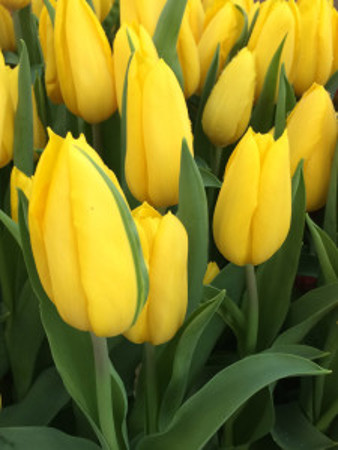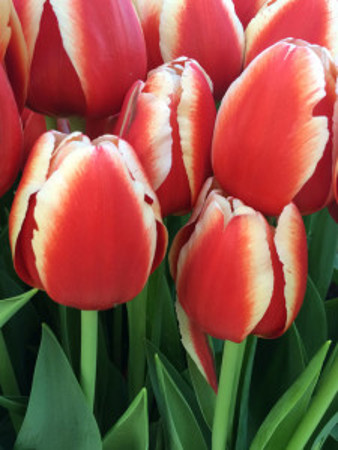Spring Flowering Bulbs
BackSpring flowering bulbs are easy to grow and are one of the true delights of gardening. Who can resist the happy face of a bright yellow daffodil heralding the onset of spring?
Spring bulbs come in all shapes and sizes and can be planted on mass in the garden or in pots for the balcony. You can even grow some in a bowl without the need for soil at all. Some, like hyacinths, have amazing perfume and many make excellent cut flowers. No matter where you live in Australia you there’s a spring flowering bulb that you can enjoy!
How To Grow Spring Flowering Bulbs
These bulbs should be planted in autumn which gives them time to grow over winter before putting on their magnificent spring show.
Plant your bulbs in a sunny or semi shaded position according to the requirements of the bulb you have chosen but make sure there’s good drainage and protection from hot winds so the spring flowers will last longer. Add some organic compost if the soil is poor. Most bulbs are planted with the pointed end facing upwards but anemone points and ranunculus “claws” should both face downwards. Plant roughly twice as deep as the height of the bulb and in loose groups for a more natural affect rather than in rows.

Paperwhite jonquils are highly perfumed
When planting into pots always use a premium quality potting mix and initially place in a shaded spot. As soon as the leaves begin to emerge move the pot into a sunny position.
Once your bulbs are planted mulch with an organic mulch and water with a solution of OCP eco-seaweed to settle them in. If you don’t like seeing the “empty” garden bed then plant low growing annuals over the bulbs like alyssum, violas or lobelia. These will quickly fill the bed and add colour while you’re waiting for the bulbs to grow.
Chilling Requirements
Many of the popular spring flowering bulbs come from regions which experience very cold winters eg tulips, daffodils and hyacinths. Without a period of intense cold these bulbs tend to grow poorly and flowering becomes unreliable after the first year. If you experience regular heavy frosts through winter then chances are your region is cold enough for success.
In regions with mild winters you can mimic cold conditions by placing bulbs in the crisper of the fridge for 4-6 weeks. Store them in a paper bag with the bulb name and date written on it so everyone knows they’re not onions! This is actually important because some bulbs are toxic to eat.
If you live in a warmer climate and can’t be bothered with chilling bulbs then choose the following which will perform well with mild winters: babianas, freesias, ixias, snowflakes and sparaxias.
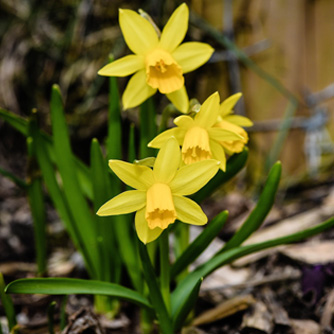
Irresistible miniature daffodils
Fertilising
After planting the bulbs top dress the garden bed or pots with some manure, compost or a pelletised organic fertiliser. Then apply a mixture of OCP eco-seaweed and OCP eco-aminogro fortnightly to push strong growth and blooms.
After flowering finishes bulbs begin storing energy and developing internal buds that will become next year’s flowers. This means it’s important to keep up the fertilising until leaves yellow. You can add another layer of manure/compost/organic pellets or just continue applying eco-seaweed and eco-aminogro every two weeks. And whatever you do don’t cut off the fading yellow leaves – let them die down naturally to allow the bulb to store as much energy as possible.
Lifting and Storing Bulbs
In theory all spring flowering bulbs can stay in the ground through their dormancy period (summer) provided the soil has good drainage and doesn’t get too wet (from rain or watering). However in practice this doesn’t always work because they’re usually planted in a garden bed full of plants which need regularly watering over summer. Exposing the dormant bulbs to this much water can cause some varieties to rot and is the reason why people dig them up (called lifting). Bulbs also get lifted if they need chilling in the fridge as mentioned above. Some bulbs aren’t so fussy and can stay in the soil undisturbed for years eg freesias, bluebells, tritelia, snowflakes and jonquils.
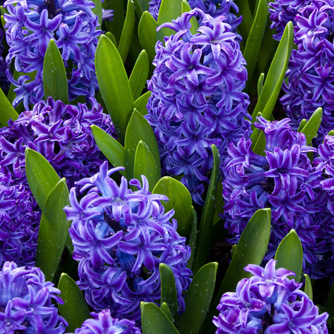
Hyacinths are also strongly perfumed
When lifting bulbs wait for the foliage to completely die down before digging. Take care to not slice through any and then remove excess soil. Allow to air dry in the shade before storing in a breathable bag in a dry, cool spot. Protect them from mice and rats which find them irresistible!
Dividing Bulbs
Over time the bulbs will naturally multiply and increase the size of the clump. Sometimes clumps end up getting overcrowded and the bulbs lose vigor with the number of flowers reducing. Fungal problems can also occur as air circulation decreases around the crowded foliage. If these problems occur wait until the bulbs die down, lift them up and divide the clumps. Give away excess bulbs to a friend or find a new position for them in the garden.
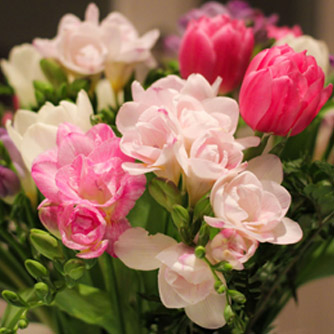
An arrangement of pink freesias and tulips
Pests & Diseases of Spring Flowering Bulbs
These bulbs are tough but can still suffer from a few nasties so watch out for:
- If aphids, mites or whitefly appear then spray with OCP eco-oil or OCP eco-neem as required at the first sign of infestation. Keeping these critters under control will also help prevent the spread of viruses.
- Caterpillars sometimes attack foliage and flower stems and can be picked off by hand or sprayed with OCP eco-neem for more thorough protection.
- Occasionally fungal leaf problems may occur, likely due to a lack of sunlight or overcrowding reducing air movement. Divide or move the bulbs to prevent the problem occurring in the next season. Spray with an organic fungicide if required.
- Check stored bulbs from time to time to ensure they are still firm and free of pests and diseases. Remove any soft or rotting ones to prevent other bulbs from being infected.
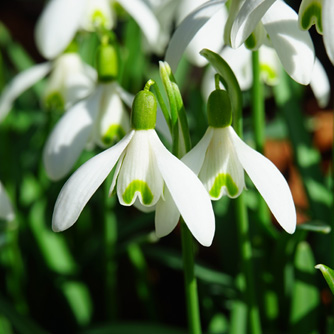
Snowdrops (Galanthus) are charming but need very cold winters
Our Spring Bulb Favourites
With so many different bulbs to choose from it’s possible to have a continuous display of flowers from late winter to the end of spring. Here are a few of our favourites to help start your selection process:
Babianas- these tough little guys will provide a splash of mauvy/blue to your garden with flowers produced on long stems. They like a full sun position and are quite dry tolerant allowing them to be left in the ground for a number of years. There are also white, yellow and red flowering types but the purple flowering babianas are the most commonly seen.
Daffodils & Jonquils – these are probably the most popular of all the spring bulbs. Daffodils for their happy faces and jonquils for their rich perfume. Colours range from white, cream, yellow, gold and even a soft pink. Plus you get flowers which are singles, doubles and miniatures! Both are ideal for growing in pots and combining with spring flowering annuals. Jonquils need less winter chill than daffodils.
Freesias- traditionally freesias had small, creamy white flowers but now they are available in a full range of bright colours. If you want the beautiful freesia fragrance then Freesia refracta ‘Alba’ is the one to grow. Freesias are perfect for growing on mass under trees or in rockeries. Be careful near bushland as they can naturalise a little too freely.
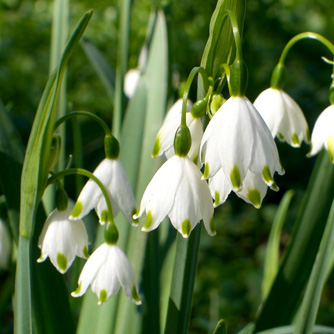
Snowflake (Leujocum) are just as charming but easier to grow in our warmer climates
Hyacinths- known for their heady perfume, hyacinths are fantastic bulbs for pots and containers as their flower spikes are particularly large and very showy. They come in a wide range of colours including blues, pinks, reds, white and even yellow. Hyacinth bulbs definitely need a good winter chill. Have a go at growing them indoors in a bowl for something a bit different.
Snowdrops & Snowflakes- these dainty fellows are often muddled up as both have small white shaped bell flowers. Snowdrops (Galanthus) are usually only grown in quite cold climates whereas snowflakes (Leucojums) are more adaptable and can grow in a range of conditions. Both are fabulous for growing under trees and in mass plantings. Bulbs can stay in the ground for many years.
Sparaxis- these hardy South African bulbs will provide vibrant colour to your spring garden as the most commonly grown variety (Sparaxis tricolour) is mix of red, orange and cream flowers with black markings. Perfect for a pot or naturalising in lawns or gardens.
Tulips- truly the most elegant of all the bulbs and with so many colours and flower shapes available choosing will be the most difficult task! As a starting point we recommend selecting shorter stem varieties for pots and long stem varieties for cutting. Tulips definitely require a good winter chill and should be lifted each year. Apply dolomite or lime to the soil before planting (especially in coastal areas) as tulips do not like acid soils. In warm climates it is best to treat them as an annual and buy new bulbs each year.
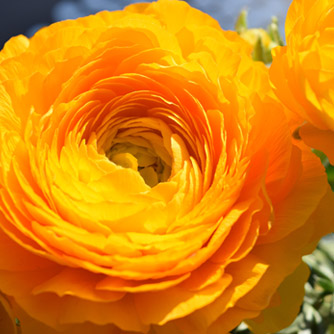
Golden orange ranunculus



